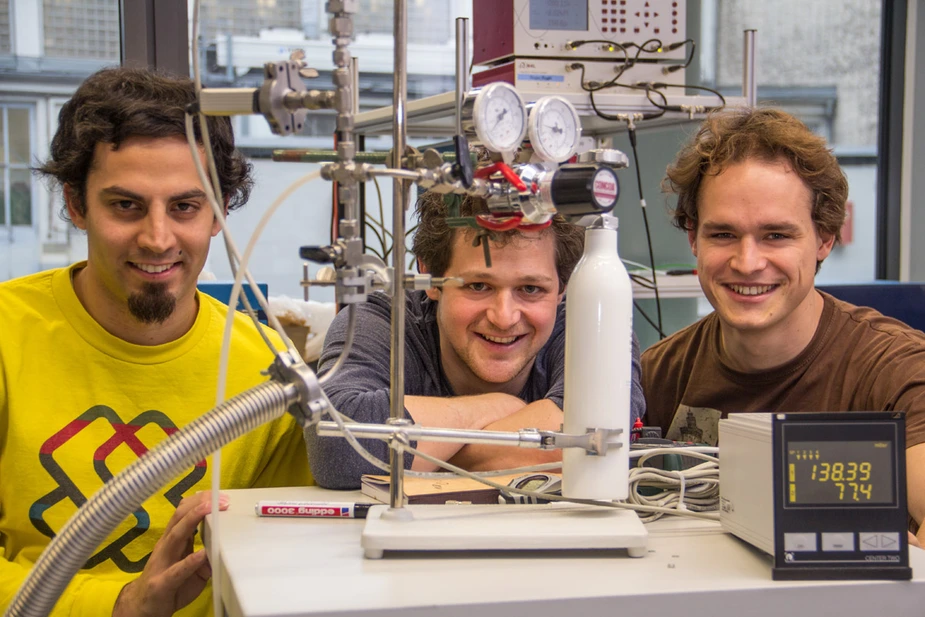Hydrogen surprise at BESSY
Electrolysis is regarded as the key technology for the energy transition
Wind and solar power can then be stored when electrolysis uses this to split water molecules into oxygen and hydrogen. Research teams all over the world are seeking ways to raise the efficiency of electrolysis. One team from Vienna and Innsbruck have made an exciting discovery at the synchrotron facility BESSY in Adlershof.
It was scarcely a year ago, but Alexander Opitz, Doctor of Electrochemistry and researcher at the Vienna University of Technology, still recalls every detail of that week in Berlin. “We conducted our BESSY experiments in two-shift work around the clock,” he reported. The team then consisted only of five who had travelled from Vienna and Innsbruck, with one electrochemist and one XPS (X-ray photoelectron spectroscopy) specialist each for the day and night shift, and the Innsbruck professor Bernhard Klötzer linking them all. “He maintained the flow of information,” said Opitz, “and he saw immediately in the spectrum that there was something completely different from what we had been expecting.”
The interdisciplinary team had come to Adlershof to analyse the XPS findings returned by the synchrotron radiation facility BESSY for the purpose of understanding how certain catalysts for high temperature electrolytic cells support the splitting of water (H2O) into oxygen (O2) and hydrogen (H2). Here, they were predominantly interested in a material for electrodes, so called mixed conductive perovskites, in this case composed of oxygen, lanthanum, strontium, and iron. The BESSY experiments conducted by the team involved the real time spectroscopic analysis of the electrolytic process on perovskite electrodes prepared in Vienna.
“We actually wanted to understand more exactly the effects of polarisation on the perovskite surface bonds,” reported Opitz – the typical questions of basic research. But then a new peak occurred in the spectrum of cathodic polarisation. Klötzer knew immediately that iron had a hand in it. Under voltage, the perovskite “exuded” metal, and reabsorbed it when the voltage was switched off. What makes this so special, though: when the metal reached the surface of the electrode, the electrolysis picked up speed, and the quantity of generated hydrogen rose dramatically.
“We were the first team to observe this effect in situ – and that completely unexpectedly,” stated Opitz overjoyed. Although it was a known fact that metal particles can grow on the surface of perovskites, their positive effects on electrocatalysis were something new. The Austrians have now applied for a further measurement session at BESSY to transfer their observations to related materials. They admit that the perovskite they use is too unstable and its conductivity is inadequate for large scale use in the cathodes of high temperature electrolytic cells. The potential promised by this surprising discovery can be exploited only when it is observed on more stable electrode materials as well. “We’re still far removed from a commercialisation,” confessed Opitz.
Besides the alternative materials, the Austrians intend to draw a bead on a further alternative for their next BESSY measurements. “We want to apply carbon chemistry to the electrode we used last time,” explained Opitz. If they succeed in processing water and carbon dioxide (CO2) together in efficient electrolysis, they could create an all new basis for generating syngas (hydrogen and carbon monoxide) or, at lower temperatures, even methane (CH4). But all this is still up in the air. Nevertheless, the very ideas show that the Austrians have made a discovery of great potential at BESSY. The greater the efficiency of the conversion, the fewer losses there will be in future for the storage of wind and solar power.
By Peter Trechow for Adlershof Special
